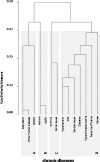Lifestyle factors and high body mass index are associated with different multimorbidity clusters in the Brazilian population
- PMID: 30458026
- PMCID: PMC6245742
- DOI: 10.1371/journal.pone.0207649
Lifestyle factors and high body mass index are associated with different multimorbidity clusters in the Brazilian population
Abstract
Multimorbidity patterns of a population can be influenced by socioeconomic and lifestyle-related factors. Some of these factors are preventable when healthy habits are promoted to the population. This study analyzed the main grouping patterns of chronic diseases and the relationship with socioeconomic and lifestyle-related factors of the Brazilian population (over the age of 18), based on a population-based survey (2013 National Health Survey). A total of 60,202 participants were included. Cluster analysis was carried out to identify the combinations of chronic diseases. Bivariate and multivariate analyses were carried out to verify the relationship between disease clusters and independent variables, utilizing Poisson's regression with robust variance, considering a 95% confidence interval. Cluster analysis revealed four disease clusters:cardiometabolic diseases/cancer, mental/occupational diseases, musculoskeletal diseases and respiratory diseases, all significantly associated with the female gender, current/past smoking habits and overweight/obesity in multivariate analyses. These aspects must be considered when planning health services and developing strategies and guidelines for the prevention and treatment of multiple chronic conditions.
Conflict of interest statement
The authors have declared that no competing interests exist.
Figures


References
-
- WHO. Global status report on noncommunicable diseases 2014 World Health Organization; 2014;176
-
- Dye C, Reeder JC, Terry RF. Research for Universal Health Coverage. Sci Transl Med. 2013. August 21;5(199):199ed13 10.1126/scitranslmed.3006971 - DOI - PubMed
-
- Diederichs C, Berger K, Bartels DB. The measurement of multiple chronic diseases -a systematic review on existing multimorbidity indices. J Gerontol A Biol Sci Med Sci. 2011;66(3):301–11. 10.1093/gerona/glq208 - DOI - PubMed
-
- Iser BPM, Yokota RTDC, Sá NNB De, Moura L De, Malta DC. Prevalência de fatores de risco e proteção para doenças crônicas nas capitais do Brasil—principais resultados do Vigitel 2010. Cien Saude Colet. 2012;17(9):2343–56. - PubMed
MeSH terms
LinkOut - more resources
Full Text Sources
Medical
Miscellaneous

